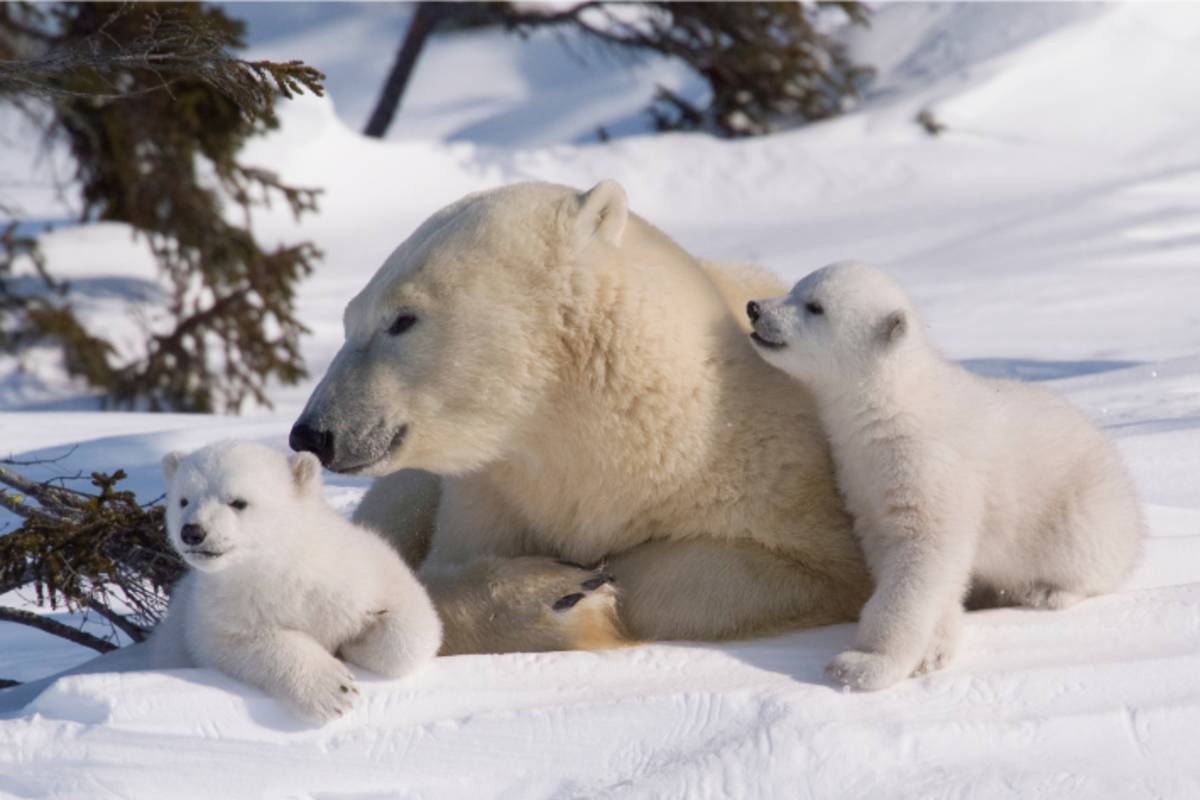Churchill, Manitoba -- February 27, 2024 -- For the 19th consecutive year, Polar Bears International (PBI), the only nonprofit organization dedicated solely to wild polar bears and their Arctic sea ice home, will host International Polar Bear Day to celebrate polar bears and how we can protect them for future generations. This event, observed annually on February 27th, brings together a global community to honor this iconic species. The celebration is timed to coincide with the time period when mother polar bears and their cubs are snug in their dens across the Arctic. The 2024 commemoration highlights protecting denning families, as denning is the most vulnerable time in a polar bear’s life. Polar bears are born blind and just about the size of a guinea pig – with less than half of all cubs reaching adulthood on average. In a warming Arctic, where polar bears already face enormous challenges, the survival of every cub is critically important. On February 27th, the group asks people from around the globe to join them in taking action to protect polar bear families. Learn more about International Polar Bear Day here.
"This International Polar Bear Day, we're calling on people to unite for a better world for future generations of polar bears and humans, as what happens in the Arctic affects the rest of the globe,” says Krista Wright, Executive Director of Polar Bears International, adding, “We’re excited to continue our fieldwork in Svalbard, Norway, working to better understand the vulnerable denning period, as the survival of every polar bear cub matters. As our research continues in a rapidly warming Arctic, we ask people to get involved and support innovative research and swift climate action.”
Research underway: Researchers from the Norwegian Polar Institute, the San Diego Zoo Wildlife Alliance, and Polar Bears International are currently in Svalbard, Norway, to conduct maternal den studies, using remote cameras to analyze mom and cubs emerging from their snowy dens. While denning is the most critical time of a polar bear’s life, it’s one of the most difficult to study. Through this collaboration, these organizations reveal the timing of den emergence, the condition of moms and cubs, and how sensitive they are to human disturbances – all helping managers and policymakers establish the best possible guidelines to protect them. Watch this video about maternal den studies.
“Keeping moms and cubs safe, while also addressing climate change, is a critical part of polar bear conservation,” says Dr. John Whiteman, chief research scientist at Polar Bears International and assistant professor of biology at Old Dominion University, adding “Cub survival is crucial to species survival, which is why we’re working to better understand and protect polar bear families during the vulnerable denning period, deploying cameras to record when the families emerge from the dens.”
Get Involved on International Polar Bear Day
Join chats with scientists on February 26 and 27:
See the schedule:
Monday, February 26th at 7 am Eastern: Video Dispatch from Behind the Scenes in Svalbard: Mom and Cub Research
Tuesday, February 27th at 11 am Eastern: Top Mom and Cubs Facts: Q&A with Alysa McCall
Learn all about moms and cubs:
Take the “Survive to 5 Challenge.” Did you know that the most vulnerable time in a polar bear’s life is from birth to adulthood at age 5? Start a “Survive to 5 Challenge Fundraiser” to help give cubs the best possible chance and invite 5 friends, family, and colleagues to participate. There will be prizes for the top three fundraisers.
Watch this video about PBI’s den-detection project, since protecting dens means protecting cubs.
Watch the Northern Lights Live Cam. While moms and cubs are in their dens, northern lights ripple above. Enjoy the Northern Lights Live Cam from explore.org, a direct charitable activity of the Annenberg Foundation, and Polar Bears International, streaming from the Churchill Northern Studies Center in Churchill, Canada – one of the best places on earth to view the aurora borealis.
Donate to protect moms and cubs. Your gift will help polar bear families, from better understanding the denning period to protecting moms and cubs from disturbances, all while addressing the overarching threat of climate change.
Spread the polar bear love:
Why act now? Recent polar bear news:
A new report analyzes collar cam footage, confirming that polar bears are unable to support themselves by foraging on land, and will continue to lose weight while on land, negatively impacting their reproduction and survival.
For the first time, scientists quantified a direct link between greenhouse gas emissions and polar bear survival. This report in Science gives emissions attribution, which is critical within policy and sustainable development frameworks.
Unless greenhouse gas emissions are curbed, most polar bear subpopulations are expected to disappear by 2100. Sea ice loss from climate change is the single biggest threat to polar bears.
About Polar Bears International
Polar Bears International’s mission is to conserve polar bears and the sea ice they depend on. Through media, science, and advocacy, we work to inspire people to care about the Arctic, the threats to its future, and the connection between this remote region and our global climate. Polar Bears International is the only nonprofit organization dedicated solely to wild polar bears and Arctic sea ice, and its staff includes scientists who study wild polar bears. The organization is a recognized leader in polar bear conservation. For more information, visit www.polarbearsinternational.org.
Media Contacts
Annie Edwards, for Polar Bears International
annie@fabricmedia.net
T: +44 07307 139782
Melissa Hourigan, for Polar Bears International
melissa@fabricmedia.net
T: +1 720-608-1919

















